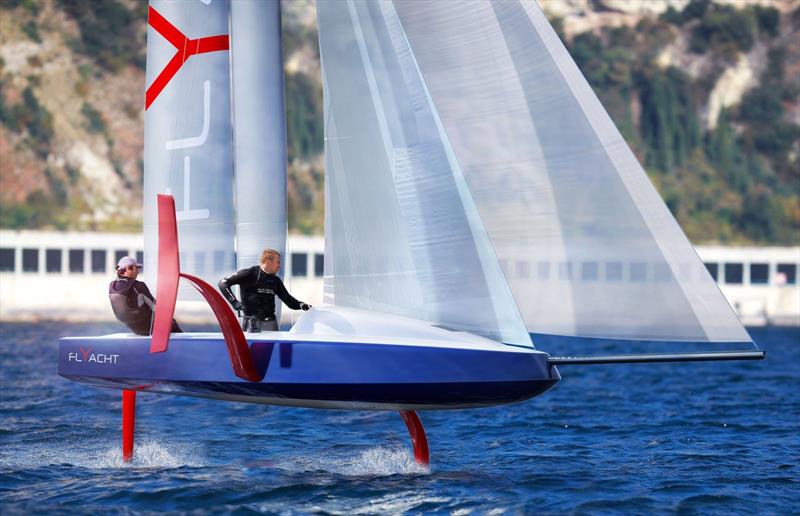
America's Cup: Mini version of the AC75 produced
by Richard Gladwell 25 Jun 2018 20:46 PDT
26 June 2018

Who said the AC75 wouldn't fly - latest from Philippe Briand - FlYacht © Philippe Briand
Six times America's Cup designer, Philippe Briand, has created a new foiling monohull which leans heavily on the concepts employed in the AC75 for the next America's Cup Class.
Named Flyacht 6.5metre foiling monohull is further confirmation that the AC75 foiling monohull concept will work as intended.
Briand is not known to be linked with any of the teams entered in the 36th America's Cup and his new design independently verifies the foiling monohull will "fly" - which has been doubted by some commentators.
Flyacht is intended to have its flight height controlled by an automated system as is used in the foiling Moth class, but which is illegal in the America's Cup where some degree of manual control is required.
After starting as a designer of Quarter Ton yachts to the rating rule of the day, his design portfolio extends to superyachts and the 139ft overall Mari-Cha IV at the time she was the world's largest racing yacht.
Flyacht is steered by a wheel - unusual for a yacht of less than 7 metres long, and will be sailed by a crew of two.
The foiling system used is similar to the AC75 in that the leeward foil is used to generate lift to raise the hull clear of the water when the breeze exceeds 10kts. The windward foil is raised clear of the water to reduce drag and with its weight used as a "canting keel" to provide positive righting moment.
It has a single T-Foil rudder which provides some degree of flight control.
The AC75 is claimed to have significantly more righting moment and therefore speed than the AC50 wingsailed catamaran used in the last America's Cup.
Sailing website sailuniverse.com describing the Flyacht says: "with a 90° righting moment, much like a Mini Transat, the Flyacht is designed to be handled by a two-man crew with the possibility of ‘hiking’ (moving the body weight as far to windward as possible to decrease heeling when sailing upwind) before take-off speed is reached in around 10 knots of true wind speed.
""The rig consists of a soft wing with slab reefing for easy bag storage and in the interests of safety stability in fly mode would be self-monitored and automated, which is not permitted under the AC75 rules.
Drawing on his experience, Philippe Briand is looking to create a low-budget project that could be built in series by a production shipyard.
“I like to be on the edge as a sailboat designer,” he says. “Our role is to transfer the benefits of innovations from the racing sector to the wider market as reasonable cost. I want to introduce the millennium generation to how much fun and excitement can be had from sailing.”
The length of the Flyacht at 6.5metres is well below the 12Metres maximum length permitted by the Rules governing the 36th America's Cup covering the use of Surrogate Yachts for test purposes.
The design concept graphic released by Philippe Briand does not show any detail of the foil raising and lowering mechanism. The rig appears to be similar to that of the AC75 with a form of a soft wingsail with skins that can be raised and lowered.
Emirates Team New Zealand commented at the time of the announcement of the AC75 foiling monohull that they hoped the concept would be adopted in a smaller form by mainstream sailing, as has happened to some extent with foiling multihulls.